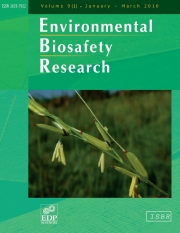Crossref Citations
This article has been cited by the following publications. This list is generated based on data provided by
Crossref.
2005.
Opinion of the Scientific Panel on genetically modified organisms [GMO] related to the notification (Reference C/ES/01/01) for the placing on the market of insect-tolerant genetically modified maize 1507 for import, feed and industrial processing and cult.
EFSA Journal,
Vol. 3,
Issue. 3,
p.
181.
Sanvido, Olivier
Widmer, Franco
Winzeler, Michael
and
Bigler, Franz
2005.
A conceptual framework for the design of environmental post-market monitoring of genetically modified plants.
Environmental Biosafety Research,
Vol. 4,
Issue. 1,
p.
13.
2005.
Opinion of the Scientific Panel on genetically modified organisms [GMO] related to the notification for the placing on the market of insect resistant genetically modified maize Bt11, for cultivation, feed and industrial processing.
EFSA Journal,
Vol. 3,
Issue. 5,
p.
213.
Ludy, C.
and
Lang, A.
2006.
A 3-year field-scale monitoring of foliage-dwelling spiders (Araneae) in transgenic Bt maize fields and adjacent field margins.
Biological Control,
Vol. 38,
Issue. 3,
p.
314.
Shirai, Yoichi
2006.
Laboratory evaluation of effects of transgenic Bt corn pollen on two non-target herbivorous beetles, Epilachna vigintioctopunctata (Coccinellidae) and Galerucella vittaticollis (Chrysomelidae).
Applied Entomology and Zoology,
Vol. 41,
Issue. 4,
p.
607.
Lang, Andreas
and
Vojtech, Eva
2006.
The effects of pollen consumption of transgenic Bt maize on the common swallowtail, Papilio machaon L. (Lepidoptera, Papilionidae).
Basic and Applied Ecology,
Vol. 7,
Issue. 4,
p.
296.
GATHMANN, ACHIM
WIROOKS, LUDGER
HOTHORN, LUDWIG A.
BARTSCH, DETLEF
and
SCHUPHAN, INGOLF
2006.
Impact of Bt maize pollen (MON810) on lepidopteran larvae living on accompanying weeds.
Molecular Ecology,
Vol. 15,
Issue. 9,
p.
2677.
Gathmann, Achim
Wirooks, Ludger
Eckert, Jörg
and
Schuphan, Ingolf
2006.
Spatial distribution ofAglais urticae(L.) and its host plantUrtica dioica(L.) in an agricultural landscape: implications forBtmaize risk assessment and post-market monitoring.
Environmental Biosafety Research,
Vol. 5,
Issue. 1,
p.
27.
2008.
Request from the European Commission related to the safeguard clause invoked by Austria on maize MON810 and T25 according to Article 23 of Directive 2001/18/EC.
EFSA Journal,
Vol. 6,
Issue. 12,
p.
891.
2008.
Request from the European Commission related to the safeguard clause invoked by France on maize MON810 according to Article 23 of Directive 2001/18/EC and the emergency measure according to Article 34 of Regulation(EC) No 1829/2003 ‐ Scientific opinion of the Panel on Genetically Modified Organisms.
EFSA Journal,
Vol. 6,
Issue. 10,
2009.
Applications (EFSA‐GMO‐RX‐MON810) for renewal of authorisation for the continued marketing of (1) existing food and food ingredients produced from genetically modified insect resistant maize MON810; (2) feed consisting of and/or containing maize MON810, including the use of seed for cultivation; and of (3) food and feed additives, and feed materials produced from maize MON810, all under Regulation (EC) No 1829/2003 from Monsanto.
EFSA Journal,
Vol. 7,
Issue. 6,
Graef, F.
2009.
Sustainable Agriculture.
p.
229.
Graef, F.
2009.
Agro-environmental effects due to altered cultivation practices with genetically modified herbicide-tolerant oilseed rape and implications for monitoring. A review.
Agronomy for Sustainable Development,
Vol. 29,
Issue. 1,
p.
31.
Heink, Ulrich
and
Kowarik, Ingo
2010.
What criteria should be used to select biodiversity indicators?.
Biodiversity and Conservation,
Vol. 19,
Issue. 13,
p.
3769.
Lang, A.
and
Otto, M.
2010.
A synthesis of laboratory and field studies on the effects of transgenic Bacillus thuringiensis (Bt) maize on non‐target Lepidoptera.
Entomologia Experimentalis et Applicata,
Vol. 135,
Issue. 2,
p.
121.
Bartsch, Detlef
Devos, Yann
Hails, Rosie
Kiss, Jozsef
Krogh, Paul Henning
Mestdagh, Sylvie
Nuti, Marco
Sessitsch, Angela
Sweet, Jeremy
and
Gathmann, Achim
2010.
Genetic Modification of Plants.
Vol. 64,
Issue. ,
p.
575.
2011.
Scientific Opinion updating the evaluation of the environmental risk assessment and risk management recommendations on insect resistant genetically modified maize 1507 for cultivation.
EFSA Journal,
Vol. 9,
Issue. 11,
2011.
Statement supplementing the evaluation of the environmental risk assessment and risk management recommendations on insect resistant genetically modified maize Bt11 for cultivation.
EFSA Journal,
Vol. 9,
Issue. 12,
p.
2478.
Pascher, Kathrin
Moser, Dietmar
Dullinger, Stefan
Sachslehner, Leopold
Gros, Patrick
Sauberer, Norbert
Traxler, Andreas
Grabherr, Georg
and
Frank, Thomas
2011.
Setup, efforts and practical experiences of a monitoring program for genetically modified plants - an Austrian case study for oilseed rape and maize.
Environmental Sciences Europe,
Vol. 23,
Issue. 1,
2012.
Scientific Opinion on a request from the European Commission related to the emergency measure notified by France on genetically modified maize MON 810 according to Article 34 of Regulation (EC) No 1829/2003.
EFSA Journal,
Vol. 10,
Issue. 5,
p.
2705.


